Xrpdguy
Hazard to Self
 
Posts: 51
Registered: 28-2-2018
Location: Serbia
Member Is Offline
Mood: Suspicious
|
|
Unknown product made by accident
Hello guys again. Yesterday i discovered one interesting product (in crystal state ) in my lab.
The main idea was making elemental iodine from povidon solution (by Nilered instructions )but it didn't work. So i left in for some time.
In the meanwhile i worked on mixture HCl-H2O2 (one of my previous posts) and benzoic acid+H2O2, so somehow one part of benzoic acid and
hydrogen-peroxide i dropped in the povidone mixture.
I was disappointed cause i thought that nothing will happen and left the contaminated povidone mixture in one large beaker for some time (2months).
From that day till yesterday no one touched that beaker and a whole liquid disappeared. At the bottom were beautiful crystals (i gave it name X).
X crystals are highly hygroscopic but only on their surface and very sticky.
Today i am gonna check its reaction with reagents, but i am curious did you ever see something like this.
At the bottom of the beaker was yellow layer and after some time a lot of foam was present.
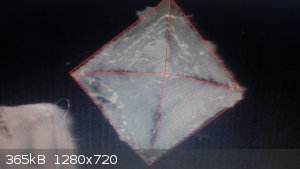 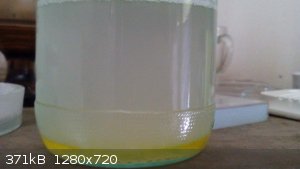 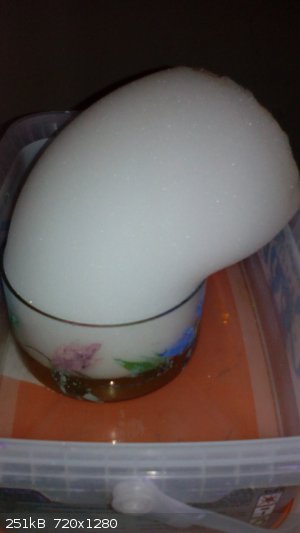
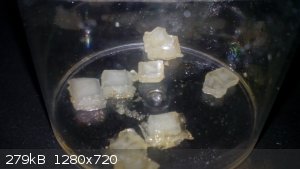 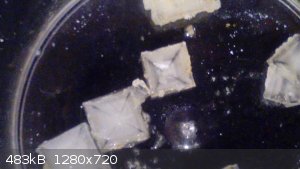
|
|
|
Xrpdguy
Hazard to Self
 
Posts: 51
Registered: 28-2-2018
Location: Serbia
Member Is Offline
Mood: Suspicious
|
|
What do you think about this? Did you see it somewhere or know which compound it should be?
|
|
|
woelen
Super Administrator
        
Posts: 7976
Registered: 20-8-2005
Location: Netherlands
Member Is Offline
Mood: interested
|
|
The foam can be explained by assuming that H2O2 slowly decomposed, giving oxygen, which leads to formation of bubbles (and hence foam) in this
solution.
I cannot say anything about the crystals. I do not know the Povidon solution you used, I assume it is a complicated mix of all kinds of chemicals and
for such things it is very difficult to say anything useful about their composition.
I suggest you to buy some real reagents, like KI, and some acid (e.g. 10% HCl will do) and do experiments with that. That allows you to make iodine
and isolate it.
|
|
|
Xrpdguy
Hazard to Self
 
Posts: 51
Registered: 28-2-2018
Location: Serbia
Member Is Offline
Mood: Suspicious
|
|
Quote: Originally posted by woelen  | The foam can be explained by assuming that H2O2 slowly decomposed, giving oxygen, which leads to formation of bubbles (and hence foam) in this
solution.
I cannot say anything about the crystals. I do not know the Povidon solution you used, I assume it is a complicated mix of all kinds of chemicals and
for such things it is very difficult to say anything useful about their composition.
I suggest you to buy some real reagents, like KI, and some acid (e.g. 10% HCl will do) and do experiments with that. That allows you to make iodine
and isolate it. |
I have mixed the Betadine 10% povidon solution with 30% hydrogen-peroxide and 5M NaOH (98%).
Crystals are insoluable in water and ethanol.
With HCl only the liquid on their surface react so the end at the bottom of the test tube are crystals with some dark orange precipitate.
In the flame crystal explode :p
With CuSO4 solution it makes light green precipitate.
Only with a mixture of NaOH+H2O2 crystals react and give some foam and blurry solution. Also some gas was produced.
After standing light-green precipitate is down layer and green clear solution is upper layer. Green solution is sensitive on light so it became brown.
More analysis i will do tomorrow.
|
|
|
XeonTheMGPony
International Hazard
    
Posts: 1636
Registered: 5-1-2016
Member Is Offline
Mood: No Mood
|
|
Sodium iodide?
|
|
|
Sigmatropic
Hazard to Others
  
Posts: 307
Registered: 29-1-2017
Member Is Offline
Mood: No Mood
|
|
Sodium iodate?
|
|
|
Deathunter88
National Hazard
   
Posts: 507
Registered: 20-2-2015
Location: Beijing, China
Member Is Offline
Mood: No Mood
|
|
There is zero point in trying to figure out what you made. As woelen said, go buy some real reagents and try do something useful.
|
|
|
Xrpdguy
Hazard to Self
 
Posts: 51
Registered: 28-2-2018
Location: Serbia
Member Is Offline
Mood: Suspicious
|
|
Quote: Originally posted by Deathunter88  | | There is zero point in trying to figure out what you made. As woelen said, go buy some real reagents and try do something useful.
|
Well, not very much people make something new or undiscovered things here.
These crystals can be very usefull as a catalyst for an oxidation of alcoholes and i started a research.
The structure and formula can be determined by some instruments, like XRD or XRPD, but i want try a determination by using some simple reactions and
discusion about it.
This post wasnt about getting iodine but determination of some unknown thing. It can be simple as NaI or NaIO3, but can be also more complicated.
|
|
|
Xrpdguy
Hazard to Self
 
Posts: 51
Registered: 28-2-2018
Location: Serbia
Member Is Offline
Mood: Suspicious
|
|
As i said crystals react with CuSO4 and make green precipitate and clear solution above it.
That solution is light-green and after some time it become dark orange, almost brown.
That brown solution i have mixed with 0.5ml of potassium-metabisulfite and got clear light-blue solution with some white precipitate.
Can you tell me what it can be?
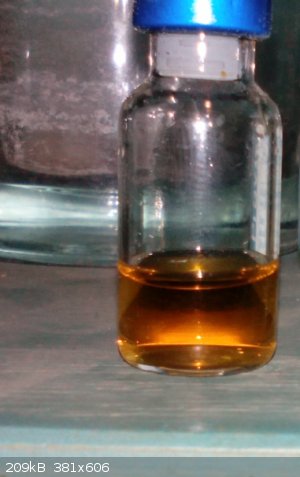 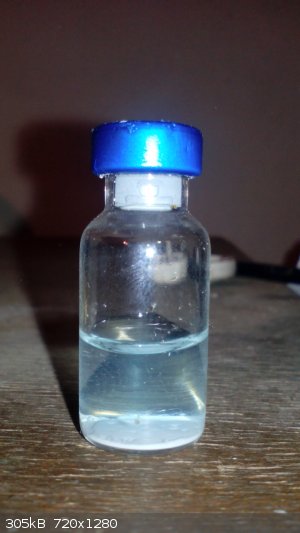
|
|
|
weilawei
Hazard to Others
  
Posts: 130
Registered: 3-12-2017
Member Is Offline
Mood: No Mood
|
|
Well, how about taking a melting point for starters?
|
|
|
Abromination
Hazard to Others
  
Posts: 432
Registered: 10-7-2018
Location: Alaska
Member Is Offline
Mood: 1,4 tar
|
|
You might have to do some hard core spectroscopy here. It would help to know the melting point of the crystals, and try doing some experiments leaning
towards the idea that it is not organic as the yellow polyme was left behind. Also be careful experimenting as anything can happen when you dont know
what it is.
List of materials made by ScienceMadness.org users:
https://docs.google.com/spreadsheets/d/1nmJ8uq-h4IkXPxD5svnT...
--------------------------------
Elements Collected: H, Li, B, C, N, O, Mg, Al, Si, P, S, Fe, Ni, Cu, Zn, Ag, I, Au, Pb, Bi, Am
Last Acquired: B
Next: Na
-------------- |
|
|
Hendrik
Harmless

Posts: 23
Registered: 29-7-2018
Member Is Offline
|
|
Could the crystals be peroxybenzoic acid? Maybe H2O2 reacted with the benzoic acid in order to make peroxybenzoic acid which would explain the
explosive nature of the crystals. Also, try to take a better picture of the copper precipitate. If it is actually pale blue instead of green, the
precipitate would be copper benzoate.
|
|
|
Abromination
Hazard to Others
  
Posts: 432
Registered: 10-7-2018
Location: Alaska
Member Is Offline
Mood: 1,4 tar
|
|
If it is peroxybenzoic acid, the melting point of the crystal should theoretically be between 41 and 42. In what way did it explode when heated?
List of materials made by ScienceMadness.org users:
https://docs.google.com/spreadsheets/d/1nmJ8uq-h4IkXPxD5svnT...
--------------------------------
Elements Collected: H, Li, B, C, N, O, Mg, Al, Si, P, S, Fe, Ni, Cu, Zn, Ag, I, Au, Pb, Bi, Am
Last Acquired: B
Next: Na
-------------- |
|
|
Xrpdguy
Hazard to Self
 
Posts: 51
Registered: 28-2-2018
Location: Serbia
Member Is Offline
Mood: Suspicious
|
|
Quote: Originally posted by Hendrik  | | Could the crystals be peroxybenzoic acid? Maybe H2O2 reacted with the benzoic acid in order to make peroxybenzoic acid which would explain the
explosive nature of the crystals. Also, try to take a better picture of the copper precipitate. If it is actually pale blue instead of green, the
precipitate would be copper benzoate. |
Precipitate is white and solution above it is pale blue.
|
|
|